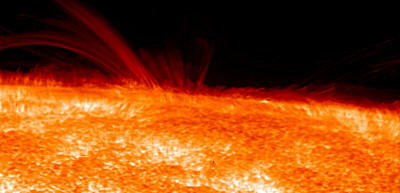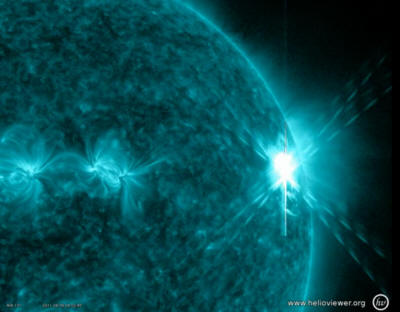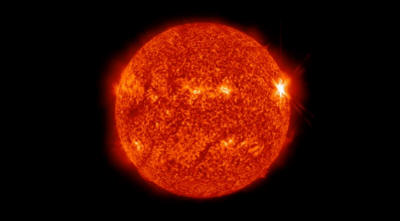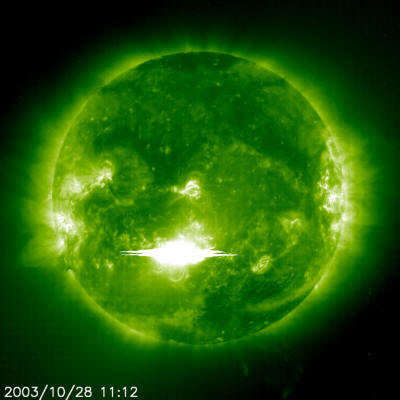|

by IB Times Staff Reporter
August 8, 2011
from
IBTimes Website

Spectacular Photos of
Solar Flares Detected by NASA
(Photo: NASA)
The National Oceanic and Atmospheric
Administration (NOAA), a federal agency that focuses on the condition of
the oceans and atmosphere, said
a severe solar storm could cause
global disruptions in GPS systems, power grids, satellite
communications, and airline communications.
With solar activity expected to peak
around 2013, the Sun is entering a particularly active time and big
flares like the recent one will likely be common during the next few
years.
Most solar flares will only cause minor problems with satellites and
power grids, but a major flare in the mid-19th century blocked the
nascent telegraph system, and some scientists believe that another
such event is now overdue.
In a
huge solar storm back in 1859, telegraph offices worldwide were
hit, some telegraph operators reported electric shocks, the
telegraph systems malfunctioned and even paper caught fire. It's the
strongest solar storm on record - and is called the “Carrington
Event” - which is named after
Richard Carrington, who viewed and
reported on the solar flare of Sept. 1, 1859.
Now, flash forward:
In 1989, six million people in Quebec,
Canada were left without power for several hours when a solar storm
took down a power grid.
According to a report by the National Research Council in 2008, a
solar storm similar to the ones in the past could cause up to $2
trillion dollars in damage across the globe today.
The NOAA predicted four “extreme” solar emissions which could
threaten the planet this decade. Similarly, NASA warned that a peak
in the sun's magnetic energy cycle and the number of sun spots or
flares around 2013 could enable extremely high radiation levels.
This is a particular problem in the U.S., especially and poses a
severe threat especially in the eastern U.S. Several federal
government studies suggest that this extreme solar activity and
emissions may result in complete blackouts for years in some areas
of the nation. Moreover, there may also be disruption of power
supply for years, or even decades, as geomagnetic currents attracted
by the storm could debilitate the transformers.
Last month, the Nuclear Regulatory Commission said U.S. plants
affected by a blackout should be able to cope without electricity
for at least eight hours and should have procedures to keep the
reactor and spent-fuel pool cool for 72 hours.
Nuclear plants depend on standby batteries and backup diesel
generators. Most standby power systems would continue to function
after a severe solar storm, but supplying the standby power systems
with adequate fuel, when the main power grids are offline for years,
could become a very critical problem.
If the spent fuel rod pools at the country's 104 nuclear power
plants lose their connection to the power grid, the current
regulations aren't sufficient to guarantee those pools won't boil
over - exposing the hot, zirconium-clad rods and sparking fires that
would release deadly radiation.
A report by the Oak Ridge National Laboratory said that over the
standard 40-year license term of nuclear power plants, solar flare
activity enables a 33 percent chance of long-term power loss, a risk
that significantly outweighs that of major earthquakes and tsunamis.
A solar flare is caused when an intense burst of radiation comes
from the release of magnetic energy associated with sunspots. Flares
are the solar system's largest explosive events.
A coronal mass ejection happens when the
outer solar magnetic fields are closed, often above sunspot groups,
and the confined solar atmosphere can suddenly and violently release
bubbles of gas and magnetic fields.
Sun Unleashes an Earth-directed...
X6.9 Class Flare
-
NASA -
August 10, 2011
from
IBTimes Website
The sun on Tuesday emitted an Earth-directed X6.9 flare at 3:48 a.m.
EDT, as measured by the NOAA GOES satellite, according to NASA.
The Solar flare peaked at 4:05 a.m..
These gigantic bursts of radiation cannot pass through Earth's
atmosphere to harm humans on the ground, however, they can disrupt
the atmosphere and disrupt GPS and communications signals. In this
case, it appears the flare is strong enough to potentially cause
some radio communication blackouts.
It also produced increased solar
energetic proton radiation - enough to affect humans in space if
they do not protect themselves.
There was also a coronal mass ejection
(CME) associated with this flare. CMEs are another solar phenomenon
that can send solar particles into space and affect electronic
systems in satellites and on Earth.
However, this CME is not traveling
toward and Earth so no Earth-bound effects are expected.
The biggest flares are known as "X-class flares" based on a
classification system that divides solar flares according to their
strength.
The smallest ones are A-class (near
background levels), followed by B, C, M and X. Similar to the
Richter scale for earthquakes, each letter represents a 10-fold
increase in energy output. So an X is ten times an M and 100 times a
C. Within each letter class there is a finer scale from 1 to 9.
C-class and smaller flares are too weak to noticeably affect Earth.
M-class flares can cause brief radio blackouts at the poles and
minor radiation storms that might endanger astronauts.
And then come the X-class flares.
Although X is the last letter,
there are flares more than 10 times the power of an X1, so X-class
flares can go higher than 9. The most powerful flare measured with
modern methods was in 2003, during the last solar maximum, and it
was so powerful that it overloaded the sensors measuring it. The
sensors cut out at X28.
The biggest X-class flares are by far the largest explosions in the
solar system and are awesome to watch. Loops tens of times the size
of Earth leap up off the sun's surface when the sun's magnetic
fields cross over each other and reconnect.
In the biggest events, this reconnection
process can produce as much energy as a billion hydrogen bombs.

This taken by
the Solar Dynamics Observatory in extreme
ultraviolet (131 angstrom) shows the August 9, 2011,
X7 class flare which started at 3:48 AM EDT from
sunspot 1263.
The brunt of the explosion was not
Earth-directed.

An x-class
flare began at 3:48 AM EDT on August 9, 2011 and
peaked at 4:05 AM. The flare burst from sun spot
region AR11263, before it rotated out of view.
The
image here was captured by NASA's Solar Dynamics
Observatory (SDO) in light at 304 Angstroms.

The Solar and
Heliospheric Observatory (SOHO) spacecraft captured
this image of a solar flare as it erupted from the
sun early on Tuesday, October 28, 2003.
Source: IBTimes/NASA Date:08/10/2011
|




